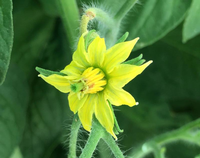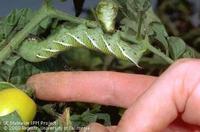Tomato Tips
Garden Help >Vegetables > Tomatoes
Here's a listing of all our tomato tips. Refer to the UC Pest Site page on tomatoes for more information about caring for tomatoes and the most common problems.
Tomato Tips for All Months
Healthy Tomatoes
Tip description
Tomatoes are one of the most popular vegetables in home gardens, largely because of the taste difference between a homegrown tomato and a store-bought tomato. Here are a few things to watch out for to keep the plants healthy. Regular watering helps nutrients flow throughout the plant and can prevent blossom end rot. Clean soil and sanitation reduce the common Verticillium wilt in which lower and older leaves turn yellow and brown. And russet mite, where lower leaves and stems appear a greasy bronze, can be controlled with sulfur dust.
Months applicable
Category
|
Late Tomatoes
Tip description

Tomato blossom
More information: Growing tomatoes in the home garden
Months applicable
Category
|
Tomato blossom end rot
Tip description
Months applicable
Category
|
Tomato Bottom Scarring
Tip description
Sometimes scarring can be seen on the bottom (blossom end) of tomatoes. This can be caused by weather conditions such as cool and cloudy weather at bloom time, making the blossom stick longer to the small fruit. The fruit is perfectly good to eat with the damaged part cut out. Some large heirloom tomatoes are more susceptible to this condition. Also known as catfacing.
Months applicable
Category
|
Tomato Hornworm
Tip description
Both tomato hornworms and tobacco hornworms can do significant damage to tomato plants. They can eat entire leaves and take bites out of the fruit. Although they are large with a striking appearance, they camouflage themselves well on plants and can be surprisingly hard to find. Once you see one, you’ll wonder how you missed it. The first clue to their presence is often a pile of frass (insect larva excrement) on the leaves or ground under the pest. They are up to four inches long so they are easy to handpick for disposal. If you see a row of white eggs on their backs, those are from a parasitic wasp that will take care of the problem naturally. They are striking, with white striping and little round circles. The caterpillars get their name from the horn on their back end, and they are the larval stages of rather large brown moths.
More information: Tomato Hornworms
Months applicable
Category
|
Tomato Russet Mite
Tip description
Tomato russet mites deplete juice from the cells of leaves, stems and fruit. They usually start at the base of the plant and move upward. If not controlled, these pests can kill plants. At first sign of damage, treat with sulfur dust or a spray solution of wettable sulfur and spreader-sticker. More information is found in the UC Pest Note on Tomato Russet Mite.
Months applicable
Category
|
Tomato Staking
Tip description
It's time to start planning how you will stake your tomatoes. You will want to stake your tomatoes right after you plant your seedlings. Here are the various Tomato Staking Techniques we have tried.
Months applicable
Category
|
Tomato Suckers
Tip description
Pinching out suckers is recommended for areas with a short growing season (for faster production) or humid summers (to improve air circulation) or to make it easier to tie plants to stakes. But with our dry climate and long growing season, there’s no need to remove them if you’re growing tomatoes in cages. Letting suckers grow provides foliage cover to shield the fruit from direct sun, gives additional photosynthesis, and will produce more fruit. Feel free to remove interior leaves that are shaded out or turning yellow, or clip foliage as needed to make the tomatoes easier to find and harvest. But no need to pinch out the suckers.
See Cultural Tips for Growing Tomatoes for information such as site selection, soil preparation, when to plant, etc. when growing tomatoes.
Months applicable
|
Watering Tomatoes
Tip description
If you haven't already, it's time to cut back on watering tomatoes. Tomatoes have far more flavor when the ripening fruit is deprived of water. Don't forget to remove competing weeds from around the garden.
Months applicable
|







 A brown depression on the bottom of tomatoes is usually blossom end rot (BER). This disorder is related to a calcium deficiency aggravated by irregular watering. Since most soils have adequate calcium, watering is usually the problem. Without regular watering, the calcium in the soil cannot reach the plant. Mulching can help. Water tomatoes regularly. Avoid flooding them so the roots sit in water. For more detailed information about BER please view
A brown depression on the bottom of tomatoes is usually blossom end rot (BER). This disorder is related to a calcium deficiency aggravated by irregular watering. Since most soils have adequate calcium, watering is usually the problem. Without regular watering, the calcium in the soil cannot reach the plant. Mulching can help. Water tomatoes regularly. Avoid flooding them so the roots sit in water. For more detailed information about BER please view 

